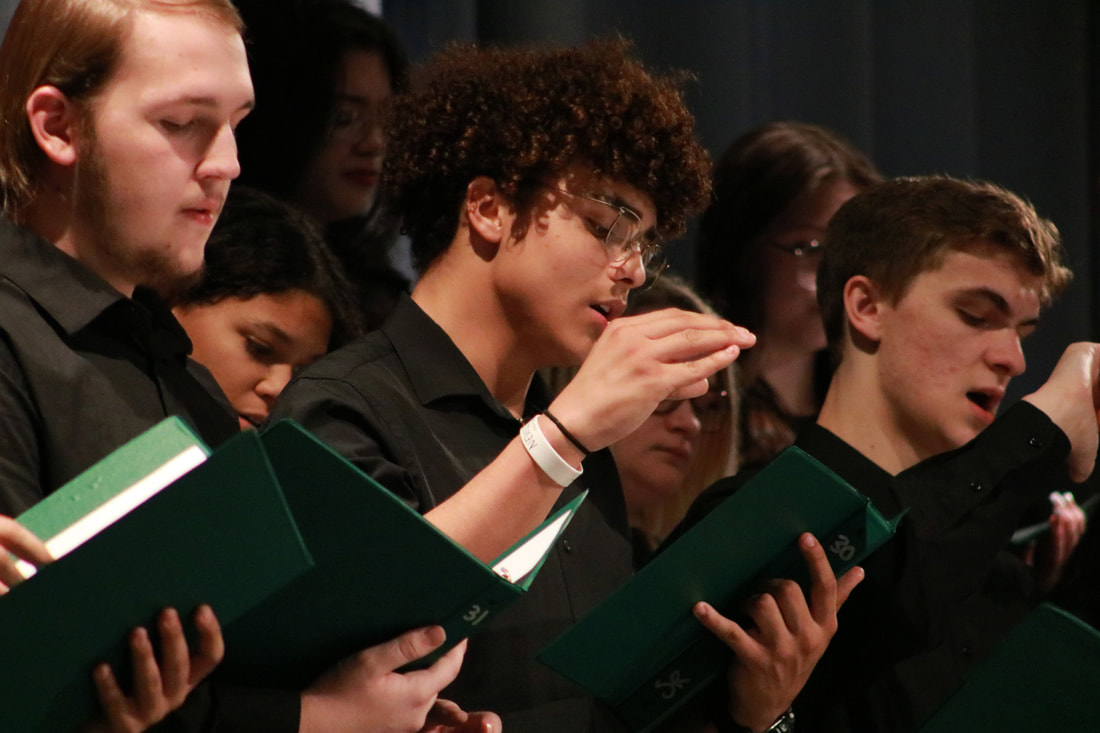|
The Breadcrumbs widget will appear here on the published site.
The Walnut Grove chorus performed its first concert of the semester on March 7 in the auditorium. And for the first time at our school, it showcased a live, evaluated sight-reading.
by Cheyenne Tolleson and Brayden Downey
The Walnut Grove chorus performed its first concert of the semester on March 7 in the auditorium. And for the first time at our school, it showcased a live, evaluated sight-reading.
As described by Junior Chazz Hayes, in sight-reading “you basically have to find where a certain note is [and sing it] without [having] ever [seen] it before.” He went on to further explain the skill as difficult to perform without proper experience. This fact led to the preparations taken in daily instruction in order to polish the skill enough for a live example. Twelfth Grader Lacie Palmer revealed how the chorus as a whole went about doing this. “We do sight-reading every day‒‒ Monday through Friday. We always [do it] before we do our songs. He gives us about 5 minutes to practice, and then, we all go over it as a class.” Freshmen Gabriella Daniel followed this up by describing how the diligent practice schedule improved voices across the board. “Constantly doing it every day in class helps because you have no choice but to learn it fluently,” she explained. “Last semester… in fourth block, we struggled a lot, and now that we’re in beginning chorus II, it's a lot better. Even new people are getting the hang of it faster.”
However, those initial growing pains were not only shared among new members of the music world. Sight-reading is not just limited to vocal performers; it is also a key aspect of performing as a band as well. Jacob Oates, a Senior and five-year band member, spoke out about what the transition from one form to the other was like. “With band sight-reading, you know where notes are because you have consistency with instruments. [However,] with your voice, it's more difficult because you have to figure everything out. Most people can't just sing a song‒‒not just by thinking about it.” He then followed this statement with a sure appraisal of the skill’s importance to a musician. “It's a skill that's worth building. It helps you learn new music a lot faster than you would be able to normally.”
Conductor and Chorus Teacher Mr. Reidling chose to take this skill to the next level for current and future members of the WGHS chorus. “We’re actually doing LGPE (Large Group Performance Evaluation), and I’m only taking one group this year. The reason that we are doing live sight-reading is to prepare us for that competitive, graded sight-reading. And, because I am not taking my other two ensembles this year, I’m giving them a chance to experience what it will be like before they go in the next couple years.” Although prep for LGPE was a starting point for the idea, Mr. Reidling added an overall token as to why he was eager to include sight-reading to the set list. “It also demonstrates to parents that these skills that they are learning in class do apply to what they’re [sight-reading]. Because in the future, the kids will be able to pick up music and read it for the first time without having to have someone feeding them notes.” As for the judge who was present for the sight-reading at this concert, she used what Mr. Reidling referred to as an “unofficial scoring system” meaning that her notes and grading were given via comments rather than the traditional numerical-based grade. Her overall, professional opinion was that “we were well on our way to earning superiors at LGPE in a few weeks” as recalled by Mr. Reidling. Concert Setlist:The Blog Tags Widget will appear here on the published site.
Tags:
The Recommended Content Widget will appear here on the published site.
Comments are closed.
|
INSTAGRAM FEED
SHARE US ON FACEBOOKNEWS WORTHY?Categories
All
|


3/8/2023